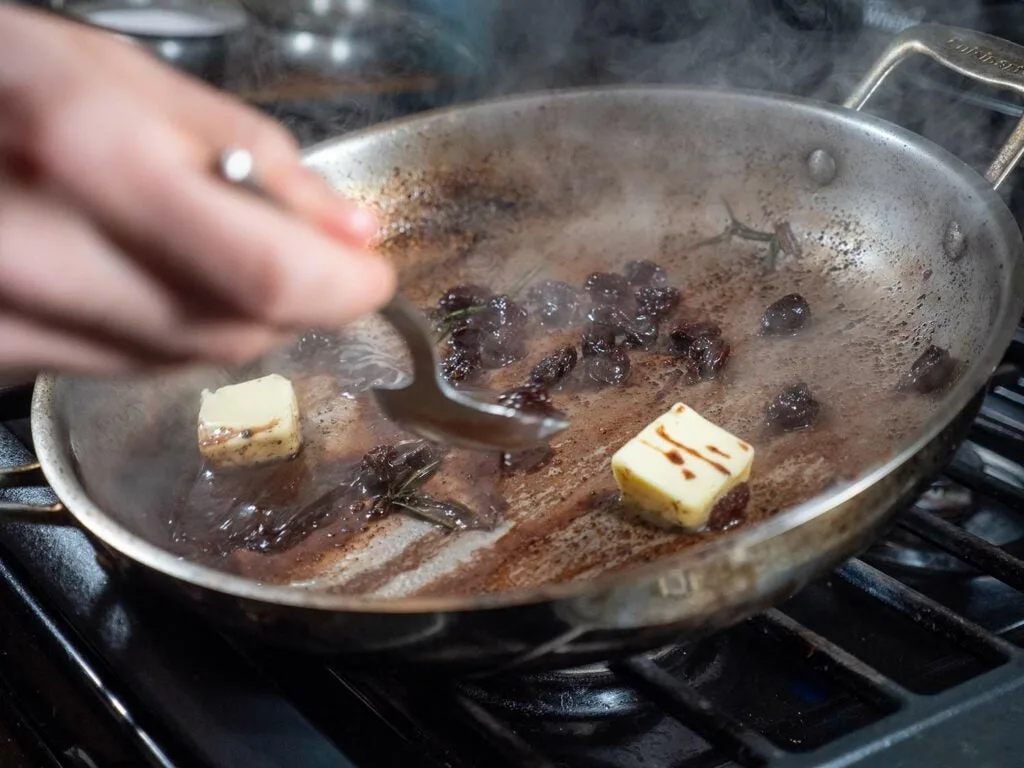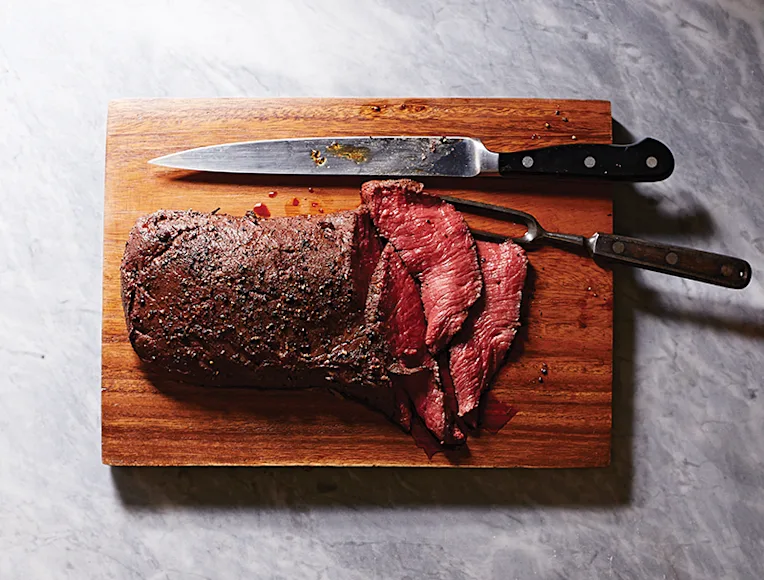As much as we love the look of a shoulder mount or deer skull on the wall—the real trophy of a successful deer hunt is the wild game we bring home. And if you were to poll 1,000 whitetail deer hunters and ask them to pick their favorite cut of venison—their trophy cut—odds are that the majority of them would select the loin—a.k.a. the backstrap.
When it comes to cooking backstrap, there’s nothing wrong with keeping it simple: seasoned with salt and pepper and cooked to no more than medium-rare. But if you’re looking for something a little more advanced, this collection of venison backstrap recipe ideas is for you.
Table of Contents
Redneck Sous Vide Venison Backstrap Recipe
Venison Backstrap Tomahawk Chop
The Reverse Sear Backstrap
How to Cook a Stuffed Venison Backstrap
Venison Backstrap Recipe Ideas for Leftovers
Smoked Venison Backstrap
Pan-Seared Venison Backstrap Recipe
7 Tips for Cooking Venison Backstrap
Redneck Sous Vide Venison Backstrap Recipe
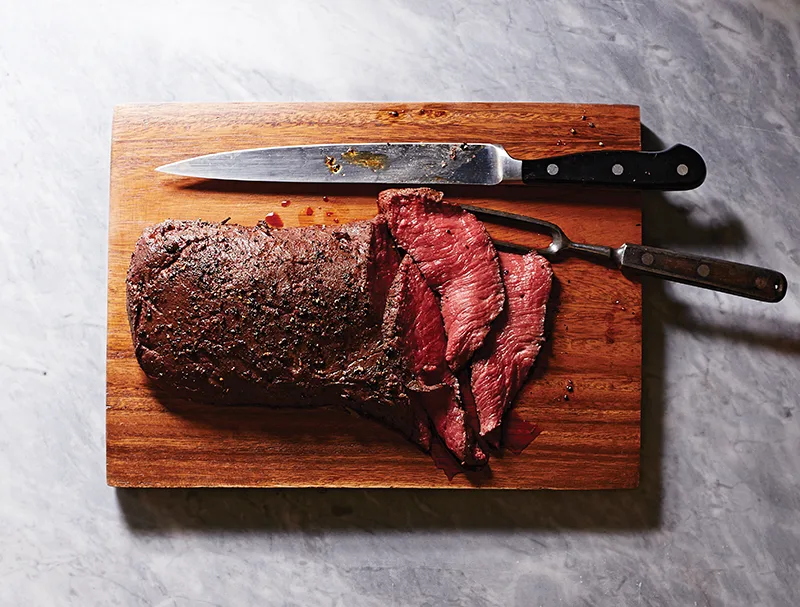
Tender, rare, and delicious.
Tender, rare, and delicious. Johnny Miller/Food Styling by Roscoe Betsill
All you need to cook a perfect venison backstrap is a cooler, a zip-seal bag, some hot water, and a digital thermometer. By perfect, I mean perfect: medium-rare from the outside in and spectacularly, succulently tender. And it’s foolproof—you can’t overcook it. And no joke: You cook it in a beer cooler. A little bit of backstory, before I tell you how.
This is a down-home riff on an avant-garde cooking technique known as sous vide (French for “under vacuum”). By vacuum-sealing meats (or anything else) and then cooking them in a temperature-controlled water bath, chefs turn out incredibly luscious cuts. Unlike traditionally cooked meats, there are no variations in the doneness—that is, there’s no pink center to a medium-rare tenderloin because the whole thing—even the outside—is uniformly pink. (The exterior can be quickly browned afterward, if desired.) Precise heat control means that medium-rare is exactly that. Sous vide has revolutionized restaurant kitchens, and thanks to the cooking-tech guru Nathan Myhrvold, who adapted a slew of laboratory-level techniques like sous vide for home kitchens in his book Modernist Cuisine at Home, and who inspired this backwoods variation, it might revolutionize your hunting camp, too.
How to Sous Vide in a Cooler
So gather your supplies. You’ll need a venison tenderloin. Ideally, your deer processor vacuum-sealed this for you. (If not, we’ll address that shortly. You can also check our our round up of the best vacuum sealers.) Next, a cooler—any hard or soft-sided cooler big enough to comfortably hold your tenderloin and at least 2 gallons of water. You’ll need the best meat thermometer you can find, too. The best kind for this technique is one with a probe connected via a cord, so you can monitor the water temperature without lifting the cooler’s lid. Here’s how it’s done from there:
Bring the tenderloin to room temperature. Fill the cooler with at least 2 gallons of 140-degree water. The hot water from my tap runs about 120 degrees, so I just amend it with some boiling water from a teakettle. Stir the water well to ensure an accurate reading from the thermometer, and adjust by adding more hot or cold water until you’re at 140 degrees. Drop the vacuum-sealed tenderloin into the water, make sure the thermometer probe is submerged, and close the cooler lid on the probe cord.
Depending on the size of your tenderloin, it should be cooked to medium-rare (126 to 130 degrees) in about an hour and a half. (The water temperature will slowly fall to about 130. If the temperature drops below 130, add more hot water.) But don’t worry about the timing—you can allow the tenderloin to sit without a single issue for up to four hours.
Your tenderloin isn’t vacuum-sealed, or you don’t own a vacuum sealer? Not to worry. Ziploc makes an inexpensive Vacuum Freezer System with a handheld pump that removes air from the bags. Alternatively, you can use a standard zip-seal bag. For that, put the tenderloin in the bag with a tablespoon or so of olive oil. Seal the bag except for a finger-size gap at one corner. Now slowly lower the bag into the water in the cooler; as it sinks, the water pressure will expel the air. Tilt the bag to submerge the sealed corner, then seal the remaining gap at the last possible moment so as much air as possible is driven out.
If you want some char or browning on the exterior of your tenderloin, roll it around in a very hot pan with some butter after removing it from the cooler. Just a minute per side will do. But the browning is optional.
The meat requires no resting time, by the way; you can slice and serve the venison the moment you lift it from the cooler and remove it from the bag. Drizzle it with a little melted butter or olive oil and season with salt and pepper.
Venison Backstrap Tomahawk Chop
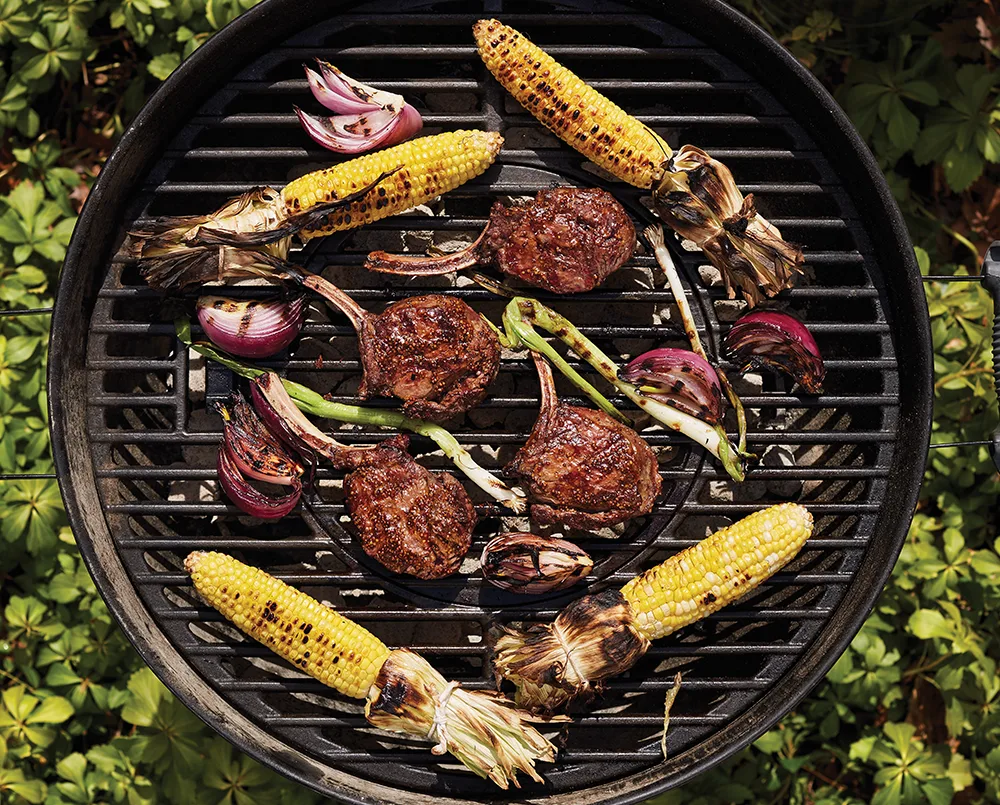
Utensils are optional for this bone-in backstrap steak. (Christopher Testani/Food Styling Roscoe Betsill)
For this recipe, from award-winning chef Charlie Palmer, who’s also a serious hunter, utensils are optional. It’s much easier, and more fun, to eat these by hand. A tomahawk chop is simply a bone-in backstrap steak. If you don’t have any in your freezer, boneless steaks or chops will do fine. They just won’t look as awesome.
Ingredients
4 backstrap chops, rib bone attached
Olive oil
Kosher salt
Freshly ground black pepper
For the glaze
1⁄4 cup Dijon mustard
2 Tbsp. soy sauce
2 Tbsp. olive oil
2 tsp. garlic salt
For the corn salsa
6 ears sweet corn, husked
1 red onion, halved
1⁄2 cup olive oil
Kosher salt
Freshly ground black pepper
2 scallions, finely chopped
4 fresh mint leaves, finely chopped
3 Tbsp. fresh parsley, finely chopped
1⁄4 tsp. cayenne pepper
3 Tbsp. red wine vinegar
1 Tbsp. sugar
Directions
Make the corn salsa: Brush the corn and onion with half of the olive oil and season with salt and pepper. Place on a grill over high heat and char, turning often to achieve a nice color and grill marks, 10 to 12 minutes. Remove and set aside until cool enough to handle.
One by one, take each ear of corn and hold it straight up on a large cutting board. With a sharp knife, shave off the kernels. Transfer the kernels to a large bowl.
Chop the charred red onion, and add to the corn along with the remaining ingredients. Mix well, taste, and adjust the seasoning. If serving within 4 hours, cover and leave at room temperature; refrigerate if held longer, and gently reheat before serving.
Grill the chops: Rub the chops on both sides with olive oil and season with salt and pepper. In a small bowl, mix together the ingredients for the glaze.
Set the chops on a cleaned and oiled grill over low heat and cook for 1 minute. Flip the chops and brush with the glaze. Flip and glaze three to four times every 2 minutes for rare to medium-rare doneness—around 120 degrees.
Transfer the chops to plates and let rest for 5 minutes. Garnish with corn relish. Serves 4
This recipe was adapted from Remington Camp Cooking by Charlie Palmer.
Roasted Venison Backstrap Recipe
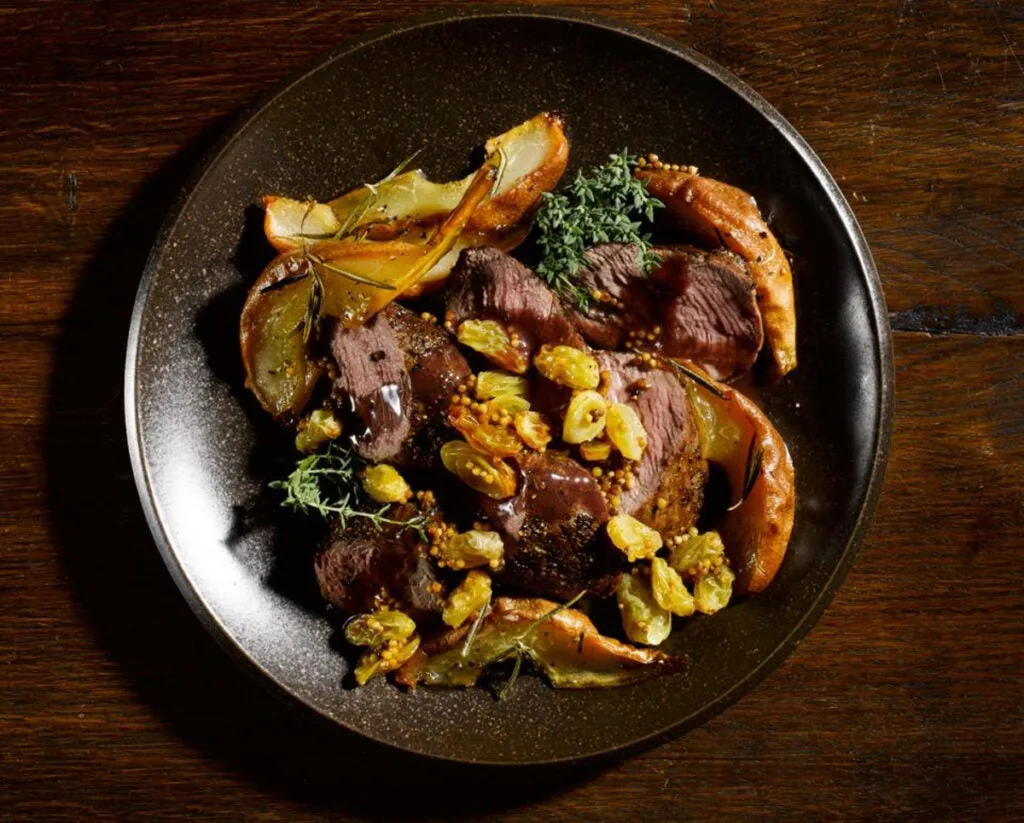
Photo by Travis Rathbone
This venison backtrap recipe comes from noted chef Paul Kahan, who says: ?My favorite venison meal was a roasted backstrap I made from a deer that my ice-fishing buddy had shot earlier in the year. I cooked it on an old propane stove in an ice shanty simply by searing and basting with lots of butter, maple syrup, and coarse black pepper. The lean meat is awesome rare and has a slight iron taste that I really love. Venison makes me think of autumn. That’s where this dish comes from.”
Ingredients
2 lb. venison loin (backstrap), cleaned of all sinew and cut in two even chunks
2 Tbsp. extra virgin olive oil
1 sprig fresh thyme
1 Tbsp. coarse cracked black pepper
1 Tbsp. grapeseed or canola oil
1⁄4 cup red wine
1 tsp. red wine vinegar
1⁄4 cup beef or chicken stock
2 tsp. butter Salt and pepper, to taste
For the roasted pears
2 ripe red Anjou pears (or other firm ripe pear)
2 tsp. grapeseed or canola oil
2 tsp. sugar 1 sprig rosemary (roughly 2 tsp. fresh rosemary leaves)
Salt and pepper, to taste
For the pickled golden raisins*
2 Tbsp. mustard seed
1⁄2 cup white wine vinegar
1⁄4 cup water
1⁄4 cup maple syrup
1⁄2 cup golden raisins
*Raisins may be pickled one day ahead
Directions
Marinate venison in olive oil, thyme, and black pepper for 2 hours to overnight.
Preheat oven to 350 degrees. Heat a heavy-bottom sauté pan over high heat until smoking hot. Add grapeseed oil and sear venison on all sides until brown.
Flip meat over and place pan in oven. Cook until internal temperature reaches 135 degrees, about 6 to 10 minutes. Move venison to a plate, and tent with foil.
In the same pan, add red wine and red wine vinegar. Reduce over high heat until thick and syrupy. Then add stock to pan and reduce until syrupy. Add butter to pan and whisk to combine. Taste and adjust seasoning with salt and pepper.
Preheat oven to 375 degrees. Core pears and cut into eighths. Toss them in a bowl with oil and sugar to coat.
Toast rosemary sprig in a dry sauté pan over medium heat until you hear a popping sound, being careful not to burn the leaves.
Add rosemary, salt, and pepper to pears and toss briefly. Transfer to an ovenproof pan and bake for 25 to 35 minutes, until tender and golden.
Place mustard seeds in a dry skillet over medium heat until they start to pop. Remove from heat. Let mustard seeds cool in the pan, shaking gently every minute or so, until toasted and fragrant.
In a small sauté pan, combine vinegar, water, syrup, and toasted mustard seeds. Bring to a boil, stirring to prevent burning.
Put raisins in a heatproof container and pour vinegar mixture over top. Let cool, then cover and refrigerate.
The Reverse Sear Backstrap
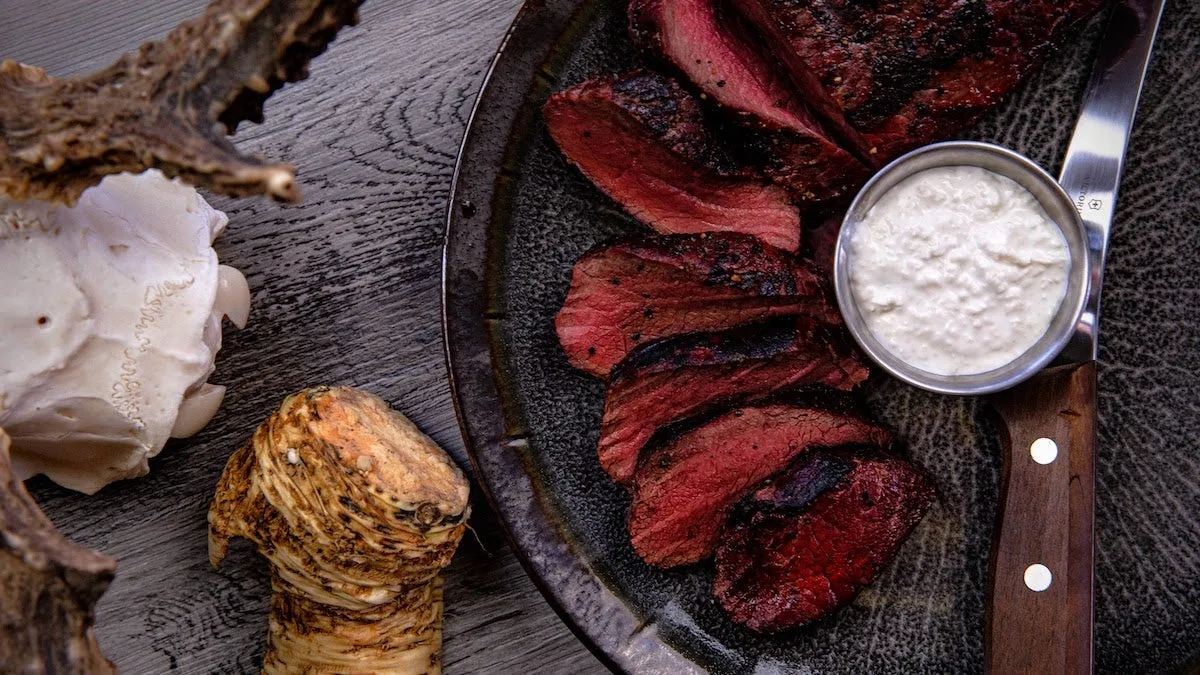
Red meat and horseradish sauce were made for each other. (Photo: Jack Hennessy)
Horseradish sauce is a mandatory condiment at any steak house worth its salt, as its fiery nature is famous for balancing the flavor of fattier cuts of beef like prime rib. One of my most distinct memories with horseradish involves the famous cocktail sauce at St. Elmo’s Steakhouse in Indianapolis. It was there a few years ago that I dipped a prawn into that spicy, lava-like liquid and took a bite, and was immediately met with a feeling that could only be described as someone taking a vegetable peeler to my forehead. But as basketball coach Al McGuire is famous for saying: “A certain amount of pain is happiness.” And this was pure bliss.
The pungent taste of horseradish is actually a result of the plant’s defense mechanism. An oil called “allyl isothiocyanate” is released when the horseradish root or leaves are cut open, creating an adverse reaction for whatever, or whoever, is chewing on it. In ancient Rome, they added raw mustard seeds to cuts of red meat, which also contain allyl isothiocyanate, to infuse spice into each bite. For me, someone who rarely, if ever, spices their wild game with anything more than salt and pepper, horseradish is the only condiment truly worthy of sitting alongside a tender cut of medium-rare backstrap.
While you can keep horseradish root in the fridge for up to three months in the vegetable crisper, it loses its pungency. Unless you plan to (and have the confidence to) plant the root and harvest it later, I suggest peeling it and turning it into coarse-cut horseradish sooner than later. Here’s how.
How to Make Horseradish Sauce
Ingredients
Kosher salt and freshly cracked black pepper
1/3 cup sour cream
1/2 tablespoon mayonnaise
2 ounces fresh horseradish, coarse cut
Dash of white distilled vinegar (1/4 teaspoon-ish)
1/4 teaspoon each of kosher salt and ground black pepper
Directions
Peel 2 ounces of horseradish root and chop thoroughly in a food processor. Add the chopped root to a mixing bowl and wait 3 minutes before adding a dash of white vinegar for hot horseradish or add vinegar immediately for mild horseradish. To the same mixing bowl, add the sour cream, mayonnaise, and kosher salt and ground black pepper. Mix thoroughly and place in the fridge until ready to serve alongside venison.
How to Perfectly Reverse-Sear a Venison Backstrap
A reverse sear simply means that you sear the outside of the meat after you’ve cooked the inside to the perfect level of doneness—in this case, medium-rare. Roasting meat low and slow before searing and carmelizing the outside gives you more control and less margin for error. You could always grill a backstrap until it’s medium-rare, but the outside of the meat will dry out before the center hits ideal temp. With a slow roast or smoke followed by a reverse sear, more meat stays tender and juicy throughout, and you still get that great crust. Here’s how to do it.
Pull a thawed backstrap from the fridge, dust all sides with kosher salt and freshly cracked black pepper, and bring it up to room temperature by letting it rest on the counter for 1 to 3 hours.
Slow roast or smoke your backstrap at 200 degrees Fahrenheit with ample airflow to all sides of the meat. This means no baking dishes. I use a stainless steel mesh grate. You want the exterior of the meat to stay dry because it will create a better sear later.
Check the backstrap periodically with a meat thermometer until the temperature reads 110, then pull it from the oven.
Lightly coat the meat in a high-heat cooking oil like peanut oil or sunflower oil and sear in a very hot pan on all sides until a brown crust forms.
After searing, pull from the pan and allow the backstrap to rest for 5 minutes on a grate, then flip and let rest for another 5 minutes so juices do not accumulate on one side and soften the crust. Carve the backstrap into ½-inch slices and serve with a side of horseradish sauce. Serves two to four
How to Cook a Stuffed Venison Backstrap

Crab-stuffed venison—the ultimate surf and turf. (Photo: David Draper)
According to reader comments, eating a backstrap any other way than seasoned with salt and pepper and grilled seems to be sacrilege. Any time you suggest slathering it with sauce or stuffing it, the outcry is loud. Still, if you have a good hunting season and have a lot of loin in the freezer, you need to get creative not to get bored with the second best cut of deer (after the shanks, of course). For that, I’d rather stuff than sauce.
There are two ways to stuff a backstrap. Longtime Wild Chef readers might remember a Food Fight Friday where I soundly defeated Anthony Licata with a crab-stuffed blacktail backstrap. To stuff that thick chunk of venison strip loin, I cut a long slit into one side of the meat, carefully working my knife to form a deep pocket inside. It was large enough for maybe ½ cup of crab meat and I sealed the hole with some fresh pancetta. The result was, dare I brag, amazing.
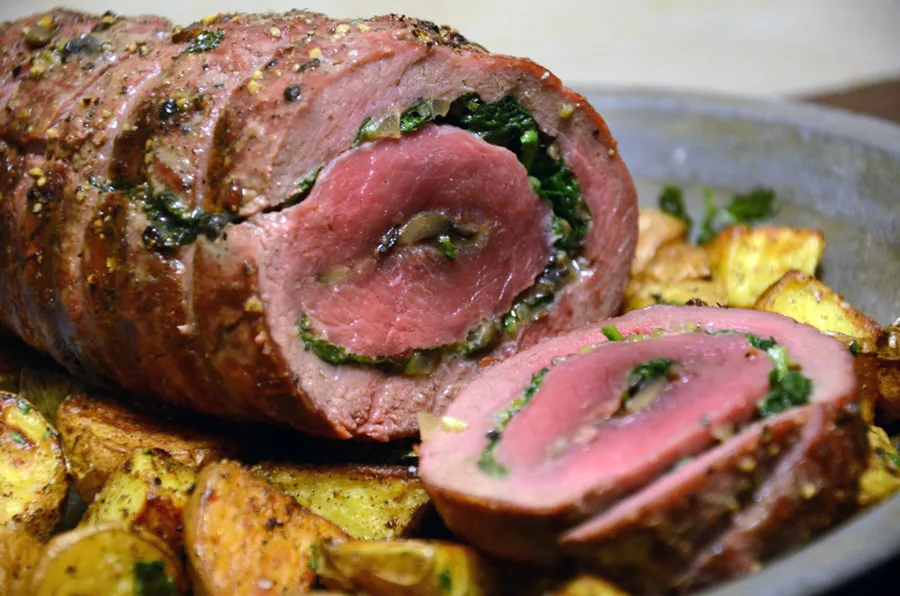
Venison roulade made with celery, mushrooms, and spinach. (Photo: David Draper)
Just the other day I found another package of backstrap from that same blacktail. Thank goodness for the vacuum sealer as that two-year old deer meat was in perfect condition. No freezer burn at all. I decided to stuff this one as well, but because it was from the rib loin section of the backstrap, which is not at thick, I used a different technique, called a roulade.
To make a roulade, you need to cut the backstrap into a thin, flat piece of meat. To do this, take a very sharp, thin knife (a filet or boning knife is perfect) and start a roll cut about ¼ inch thick along the bottom of the loin, parallel to the cutting surface. As you make your cut, unroll the thicker part of the meat as you go until you have one large, flat piece of meat.
Try to make the cut so the meat is evenly thick across the whole piece, but don’t worry if you have some thick spots. You can easily pound this down with a meat mallet, or the spine of your butcher knife. Then slather on your stuffing, keeping about a ¼-inch border around the edge of the meat. For this one I used sautéed celery, mushrooms, and baby spinach, and topped it with a little bit of crumbled Maytag blue cheese—just enough to give it a kick, but not so much that it overpowered the blacktail. Starting at one end, roll the loin and stuffing into a spiral (otherwise known as a roulade) and tie with butcher’s twine at ½-inch intervals to hold it together on the grill
Venison Backstrap Recipe Ideas for Leftovers
Leftover and backstraps—two words that really should never go together, but sometimes I’m left with a few extra steaks at the end of the night. Reheating them the next day never ends well, so instead I’ve come up with a few go-to venison backstrap recipe ideas that recycle loins (or any venison steak) with the class they deserve.
Horseradish Pinwheels: A great appetizer or game day snack. Slice backstrap into ¾-inch wide strips. Smear with horseradish and roll into pinwheels. Serve atop melba toast or other crispy cracker.
Chicken Fried Steak Slider: If you did the right thing and cooked your backstrap no further than medium-rare you can repurpose it into mini chicken-fried steaks that fit perfectly on a slider-sized roll. You should have a chicken-fried steak recipe in your pocket.
Steak Quesadillas: Lay a heavy layer of shredded Colby jack and queso fresco onto a flour tortilla. Sprinkled diced backstrap on top. Add jalapenos (pickled or fresh) and top with a second tortilla. For a quick snack, make these in the microwave, but cooking them under a broiler or in a hot skillet adds a satisfying crunch.
Backstrap Hash: My love of hash is well-known and there is none better than hash made with backstrap. (Okay, maybe short-rib hash comes close.)
Bleu Cheese Backstrap Biscuit: Just what it sounds like it. A hot biscuit. Backstrap sliced thin. Some crumbled bleu cheese and a pinch of arugula. Score big bonus points with a schmear of tomato jam.
Smoked Backstrap
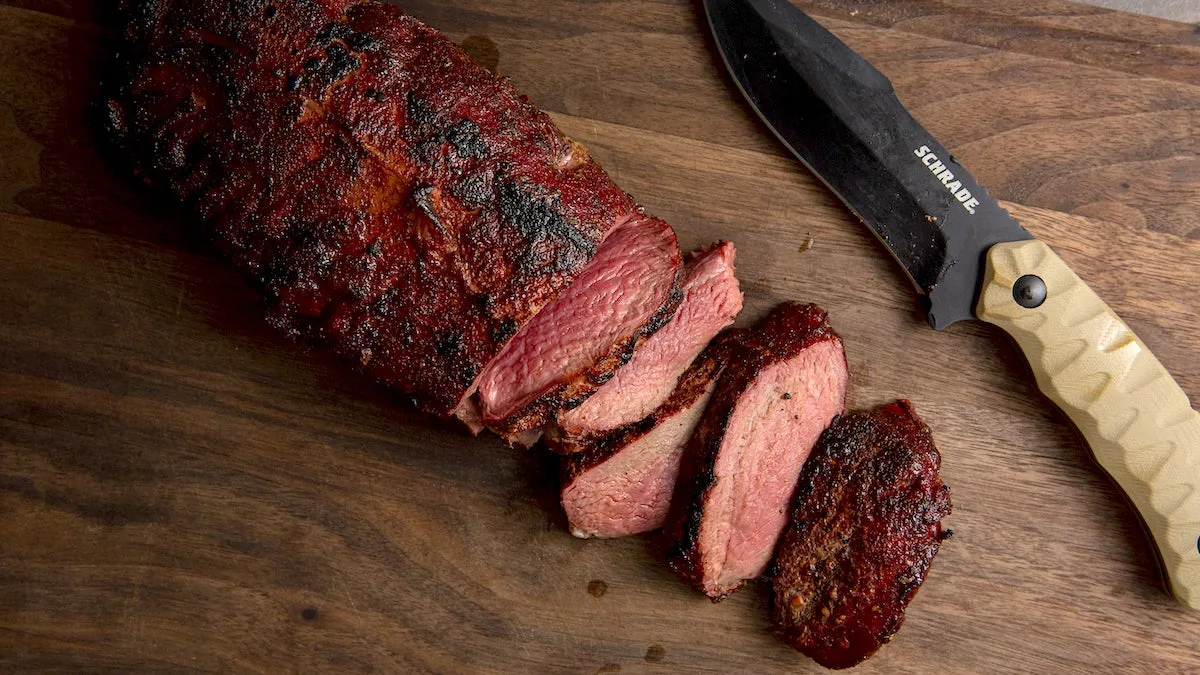
Smoked backstrap can dry out if you’re not careful. (Photo: Jack Hennessy)
The reason why you should smoke a backstrap within three hours of pulling it from the freezer comes down to more than just convenience. It comes down to science. Hot smoke is attracted to cold, wet meat.
The longer meat creates evaporating moisture, the longer smoke will adhere to it—giving that smoke more time to flavor the meat. In the case of a partially frozen backstrap, moisture will evaporate during the entire smoking process, and the cold, wet surface of the meat will constantly attract smoke particles.
But creating a smokey flavor is only part of the equation when smoking a backstrap. The most important thing to remember is to not overcook the meat. That’s why I suggest using a meat thermometer and pulling your backstrap from the smoker early for a reverse sear.
This gives you more control over the level of doneness and lets the spice rub turn into a perfect caramelized crust. I used Meat Church’s Honey Hog BBQ for this recipe, but any spice rub that incorporates sugar and salt works just fine.
Ingredients
Thicker half of a deer backstrap, approximately 2-1/4 pounds
Favorite spice rub, or an ample amount of kosher salt, freshly cracked black pepper, and a bit of brown sugar
Cooking oil spray
Directions
Pull two 8- to 10-inch long pieces of backstrap from the freezer and let them sit at room temp for 2-1/2 hours. Once they’re partially thawed, trim away any silver skin or fascia. Rub down the meat with your favorite spice mix and allow it to sit for another half hour to absorb the spices.
At the half-hour mark, add the backstrap pieces directly onto the grates of a smoker or pellet grill set to 160 degrees. Make sure there is ample airflow around all sides of the meat. Insert a meat probe in each backstrap to monitor the internal temperatures. Smoke for a half-hour. Then raise the smoker or pellet grill to 225 and smoke for another hour and 10 minutes or until the internal temp reads 110 degrees.
Spray each backstrap with cooking oil spray. Add to a cast-iron or mild-steel skillet heated to 600 degrees—or as hot as you can get it. Sear each side for exactly 1 minute for a hearty crust. Remove the backstrap from the pan and allow it to rest for 10 to 15 minutes before carving. This should give you a perfectly medium-rare backstrap.
Pan-Seared Venison Backstrap Recipe
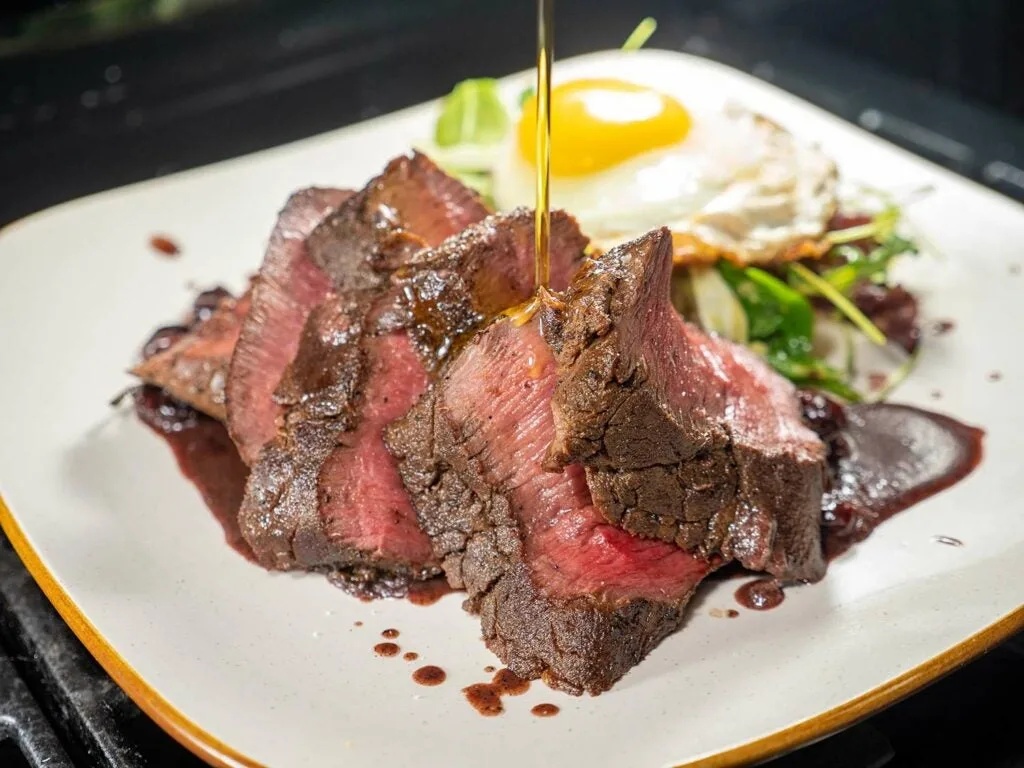
A drizzle of olive oil or some compound butter never hurt to finish a piece of venison. (Photo: Cosmo Genova)
Admittedly, this is pretty much a chefy venison backstrap recipe for steak and eggs, but it’s also a blueprint. If you can execute the technical aspects of cooking backstrap you can serve it at whatever temperature and pair it with whatever you want. By practicing and knowing and what to look for at each step, you’ll gain insight and control of the process no matter the method.
Ingredients
For the dry rub
¼ cup kosher salt
1 Tbsp. black pepper
2 tsp. onion powder
2 tsp. garlic powder
3 Tbsp. brown sugar
2 Tbsp. ground dark roast coffee or espresso
2 tsp. smoked paprika
1 tsp. chili powder
For the backstrap and sauce
6-10 inch piece of backstrap
2 Tbsp. butter
1 Tbsp. vegetable or olive oil
¼ cup dried cherries
½ cup red wine
½ cup beef or game stock
1 tsp. brown sugar
1 pinch salt
1 pinch pepper
For the salad
1 cup arugula or spring mix
⅓ cup shaved fennel
¼ cup red onion
For the salad dressing
Add all ingredients except oil to a bowl, beat ingredients with a whisk rapidly then slowly add the oil. Use as much or as little oil as it takes to thicken the dressing without oversaturating it.
1 Tbsp. whole grain mustard
1 Tbsp. apple cider vinegar
2 Tbsp. olive oil
1 pinch salt
1 pinch pepper
1 egg
Directions
Clean and dry backstrap, thoroughly coat it in dry rub.
Get a stainless steel pan piping hot but not so hot as to burn your oil. Add about a tablespoon of oil and sear the backstrap on one side in the pan. Once a crust forms, flip and sear on all remaining sides and ends evenly.
Lower the heat. Melt a pad or two of butter in the pan, and spoon the butter over the meat, basting it. (Note: This step is optional.)
Wipe out any burned oil or spices from the pan with a paper towel.
Transfer the backstrap to another pan and place it in an oven preheated to 425°F for around 3-5 minutes for rare to medium-rare. This amount of time may vary depending on the size and thickness of the portion.
Remove the backstrap from the pan to rest while you make the sauce.
Drain the majority of oil/butter and return the searing pan to the stove on medium-high heat.
Deglaze pan with wine, add stock, dried cherries, brown sugar, then whisk and reduce until cherries have hydrated and the sauce has thickened. As it thickens, add a little more butter to help smooth out the sauce. Season with salt and pepper to taste
Fry the egg in a separate pan.
Slice backstrap against the grain and serve with the cherry sauce, arugula salad, and a fried egg.
7 Tips for Cooking Venison Backstrap
After a big meal and a few drinks, my buddy and I recently got to talking about all the ways people mess up their game meat. My friend is a sous chef from Ithaca, NY, and we try to get together a couple times a month to cook wild game. Typically, the topic of conversation strays to venison backstrap recipes—how to prepare and cook those amazingly wonderful lengths of deer meat that lie along the outside of the backbone next to the hide.
From a culinary perspective, there are certain principles that professional cooks tend to agree upon when it comes to preparing a piece of meat such as a backstrap. Having both spent time in kitchens over the years, professional and otherwise, we’ve developed a few opinions of our own. The following are a few of the best practices to get the most out of nature’s finest protein.
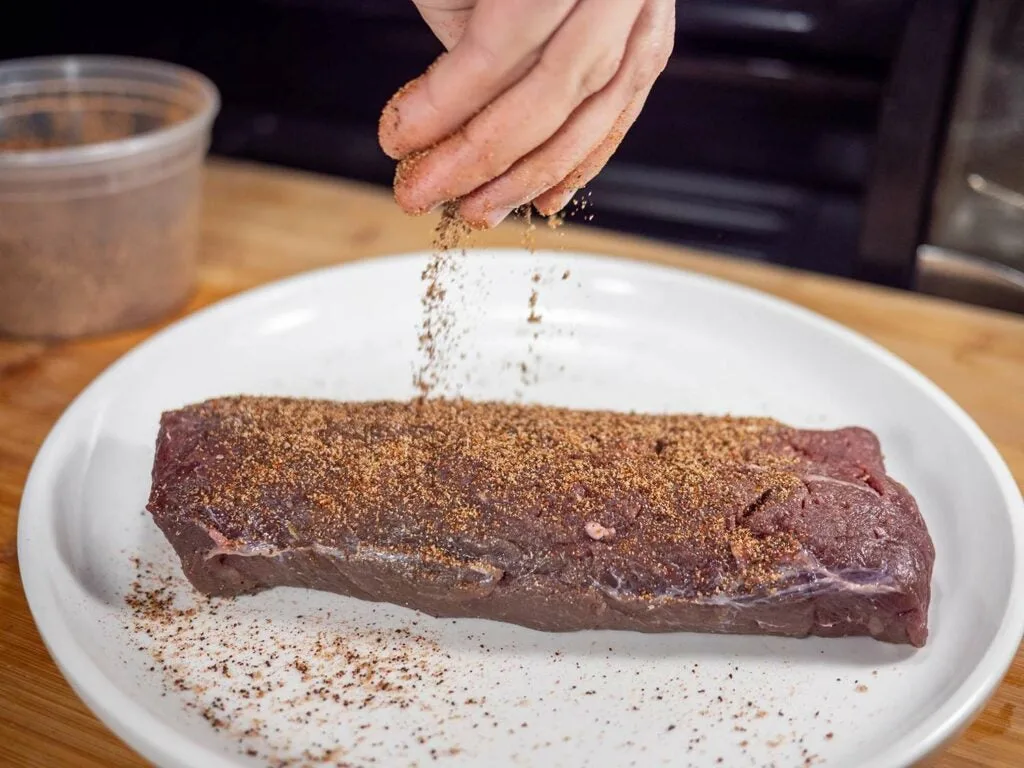
Dry rubs build the flavor profile of your dish and provide structure to the exterior crust. (Photo: Cosmo Genova)
1) Venison Backstrap Recipes Should be Simple
Of course, cooking is about more than doing things “perfectly.” Certain meals represent memories of people and places, and this is not a story about trash-talking your granny’s beloved recipe.
If your favorite way to enjoy venison is chicken-fried backstrap or teriyaki stir fry, we won’t begrudge you. That being said, a backstrap is something special to be cooked and eaten with care. For me, that means thick, perfectly seared and rested loins cooked to rare or medium-rare and sliced against the grain. Everything else—seasonings, sauces, sides, etc.—change freely, but the basic formula is almost always the same.
In general, the best way to prepare deer backstrap is often the simplest. Stuffing, bacon wrapping, or smothering venison backstrap in heavy marinades can transform and overpower the flavor and texture of the meat. These preparations have their place and can be done well, but they aren’t usually my first choice.
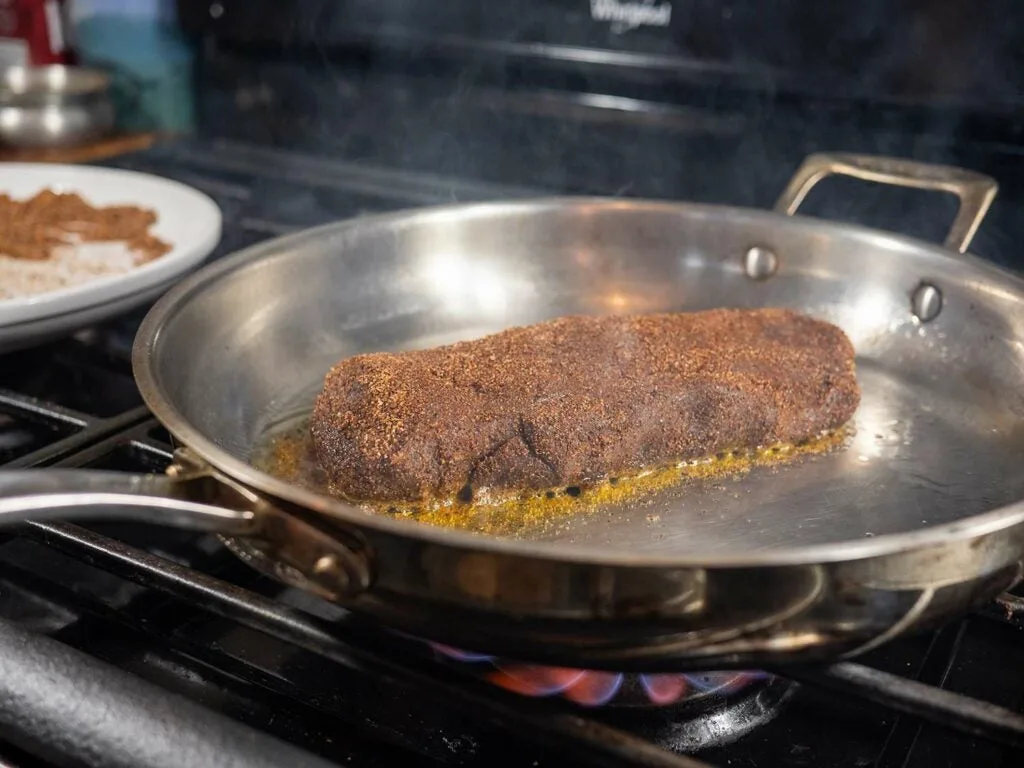
A proper sear is most important step in cooking perfect backstrap. (Photo: Cosmo Genova)
2) Cut Deer Backtrap into Large Portions
One of the simplest ways to improve a backstrap is to cut it into larger portions while butchering—and that goes for when you’re freezing it or cooking it, too. When you cut backstrap into small chunks, strips, or medallions, you dramatically reduce the tenderness and juiciness of the meat by making it much more difficult to sear properly. This is because smaller pieces take up more surface area in the pan (or grill) than one or two large pieces. They absorb more heat than is being generated, which drops the temperature of your cooking surface. If the surface is not hot enough to maintain a sear, the moisture from the meat will seep out, and it will basically braise itself in its own juices.
The outcome will be chewier, drier, likely overcooked, and can lack certain textures and flavors compared to a properly portioned and seared piece. Larger pieces are also easier to cook. A split-second loss of attention might spell doom for a small cutlet, but a larger filet won’t be as delicate. For these reasons, I typically cut a backstrap in 6- to 12-inch pieces.
I also recommend cooking larger cuts of backstrap for recipes such as tacos or stir-fries, that call for bite-sized pieces. Cook the meat properly, slice, then incorporate it into your recipe. Don’t just cut it up raw, toss it together in your pan or grill, and hope for the best.
3) The Best Methods for Cooking Venison Backstrap Recipes
My friend and I think the best two way on how to cook a venison backstrap recipe is either seared in a pan and finished in the oven, or simply grilled. Any pan will work for searing, with the only caveat being if you plan to make a sauce in the same pan after searing, you’ll want to use something like stainless steel and avoid cast iron because acids in the sauce can pull out odd flavors from the cast iron’s seasoning. Stainless steel and other quality non-coated pans can handle the oven and work great for pan sauces because any drippings from the meat or crusty bits from the searing process can be deglazed and scraped off to form the base for your sauce.
Pretty much all the same principles from pan-searing apply to grilling, so start with a clean cooking surface, get it piping hot, form a proper sear on your backstrap, then lower the temperature and use indirect heat until the meat is ready to rest. Grilling over charcoal or wood really does something special to the meat, but propane grills make temperature regulation significantly easier.
Lately, sous vide circulators and pellet grills have become popular, and honestly, they both work great. That being said, the crusty line cook in me would rather stick to what I know. I’m not above using them, but these methods are slow, and I’m impatient.
Whether sous vide or smoking, the basic idea is to cook the meat using indirect heat until it is slightly below your desired temperature before quickly searing it. This is called a reverse sear. Both methods work well to infuse flavor and slow down the cooking process giving you complete control of the backstrap’s temperature. There’s much less chance you’ll accidentally overcook or dry out your meat with pellet grills or sous vide because they take out much of the guesswork.
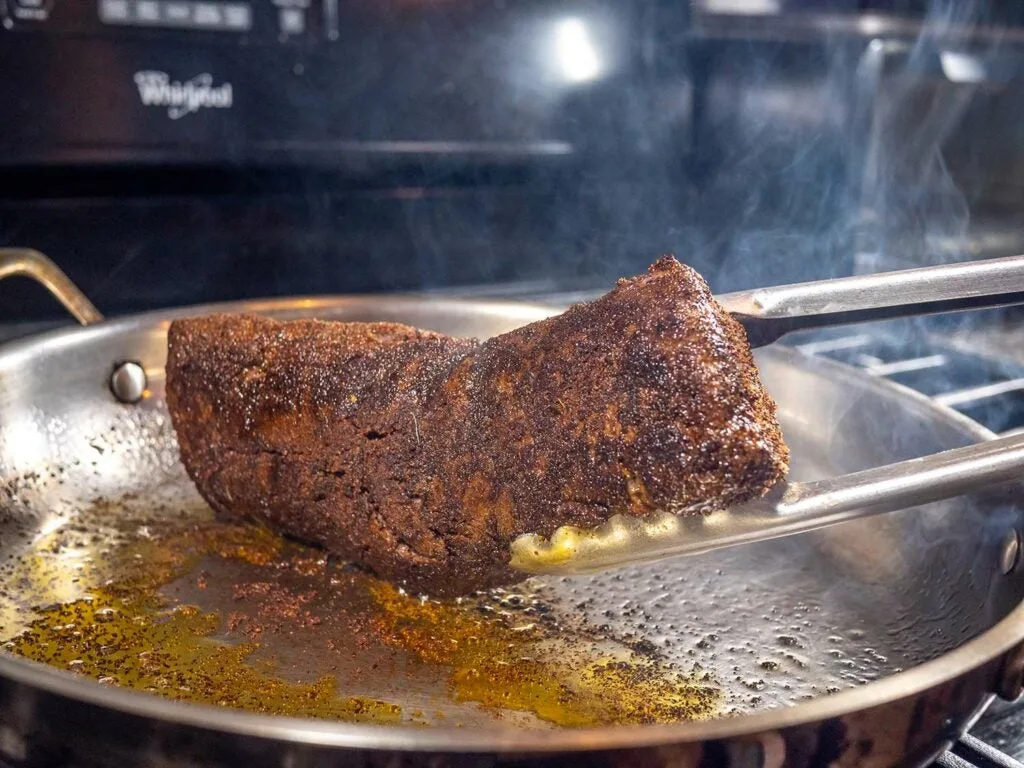
A proper sear. Notice the exterior crust. (Photo: Cosmo Genova)
4) How to Sear a Venison Backstrap Perfectly
Searing is probably the most important step for the majority of cuts—backstrap or otherwise—and also where most people have trouble. The main function of a proper sear is to scald and caramelize the meat, creating a crust layer that prevents moisture from escaping. When a piece of meat heats up, it starts to leech moisture and proteins, and searing builds structure to stop it.
The biggest mistakes people make come down to bad temperature regulation and overcrowding of the pan or grill. When a pan isn’t hot enough, it not only fails to sear, but the meat sticks to the pan and any crust layer that did form tears away. To ensure a proper sear, portion correctly, use a super hot pan, cook in smaller batches, and be patient before you start poking or flipping the meat too soon. On the initial sear, I try not to touch the meat until I’m just starting to wonder if it’s going to burn. Repeat the sear on all sides, and even the ends if you can.
This browning—also known as the Maillard reaction—is a chemical reaction between amino acids and reducing sugars that gives seared/browned foods that distinct umami (meaty) flavor. There’s a night-and-day difference between a piece of meat that has been properly browned and one that has not, and the correct execution of that first step will set the stage for the rest of the cooking process and ultimately determine the deliciousness of your food—whether your cooking backstrap or another cut of meat.
For pan-searing, you’ll want to use some sort of fat as a cooking medium. Those with a higher flash point such as vegetable oil are technically superior, but you can also use other fats like olive oil, bacon fat, or butter. You’ll just need to be more proactive in regulating the temperature to avoid burning.
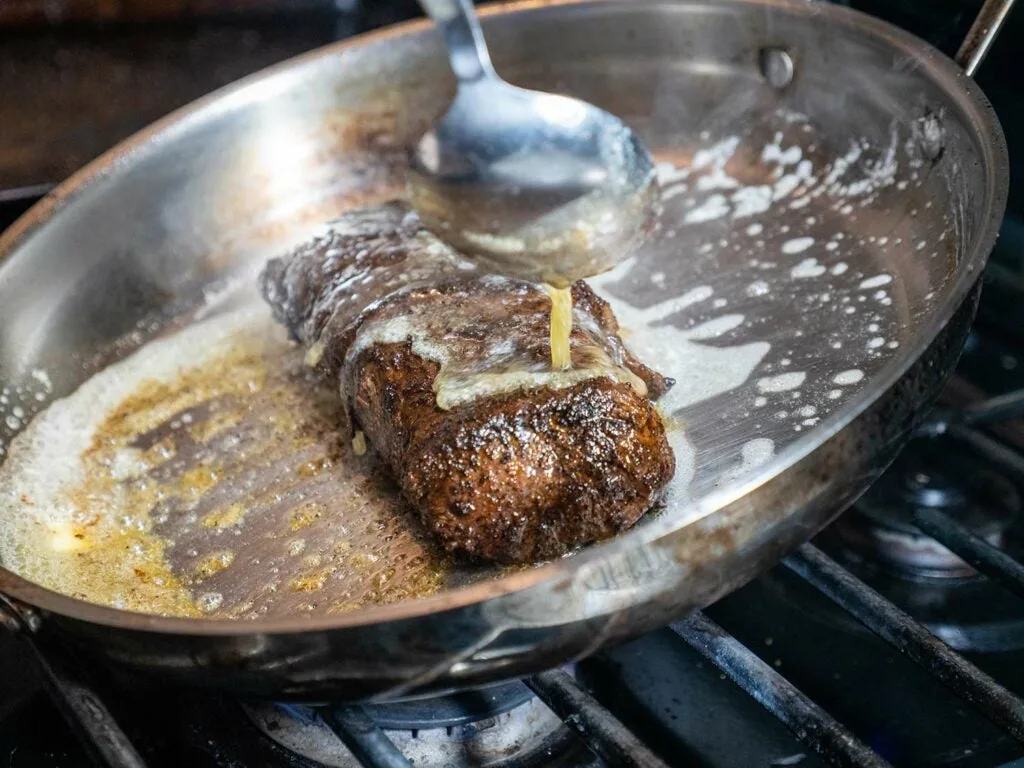
Basting the backstrap in the oil or butter you seared it in will help form the exterior crust and keep the inside juicy. (Photo: Cosmo Genova)
5) Avoid Marinades with Venison Loins
You want to keep a backstrap as dry as possible throughout the cooking process to ensure a better crust, juicier inside, and more consistent doneness. Whether pan searing or grilling, you can achieve this by using high, dry, direct heat, and minimizing things like marinades.
Marinades can be great for grilling but are often too wet to get a proper pan sear. Although, the right marinade can actually help form an amazing crust if you can keep your pan hot enough to evaporate the moisture. If I do marinade a backstrap, I keep it extremely simple—seasonings, olive oil, maybe something garlicky or acidic, and something sugary to help caramelization.
While marinades have their place, I generally prefer to use a dry rub instead. I’ll mix it up depending on what I’m going for, but there are a ton of blends on the market if you don’t want to make your own. I highly recommend a dry rub called, Musketpowder.
.
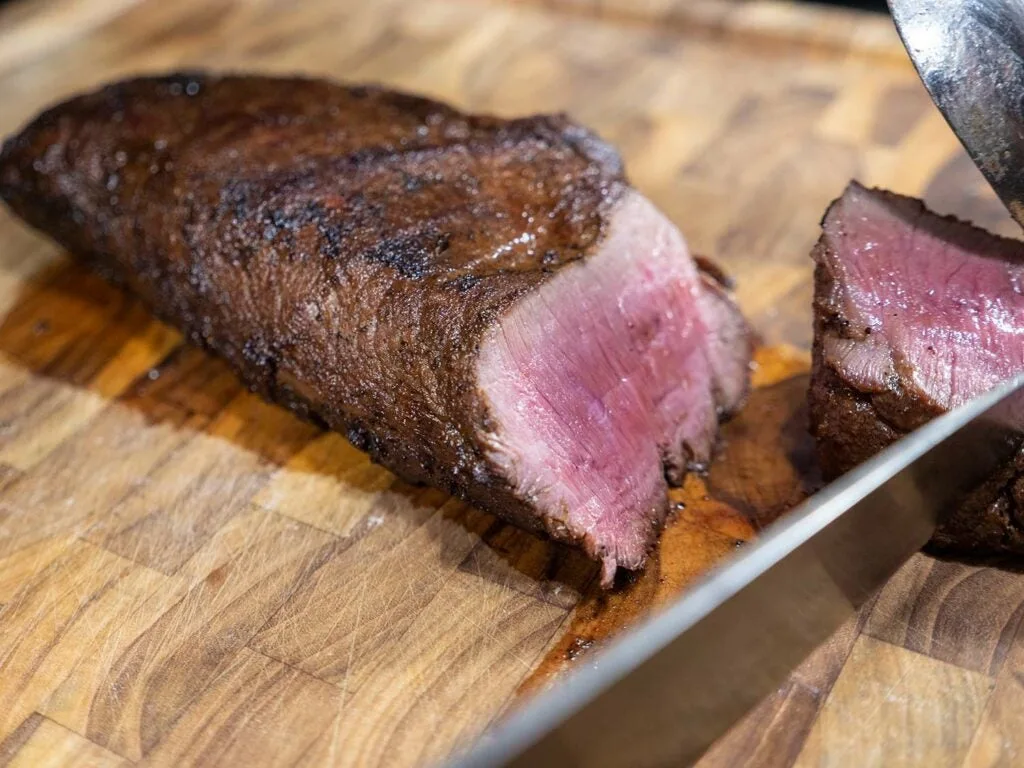
The perfect rare to medium-rare we’re looking for. (Photo: Cosmo Genova)
6) The Best Internal Temperature for Deer Backstrap
A venison backstrap recipe is best served between rare or medium (and that’s pushing it). Period. The end.
But if you want to nail your temps like a pro, you’ll need to learn to gauge doneness without cutting holes in your meat. There’s no point in painstakingly containing juices with a perfect sear if you’re just going to stab it with a knife to see what the center looks like. Stick and probe thermometers are handy tools, but with some experience, you can learn to intuit doneness by hand.
Here’s a trick most professional cooks use to gauge doneness:
Open and relax one hand. With the pointer finger on your other hand, feel the pad on your palm just below your thumb. The firmness you feel is roughly comparable to an uncooked, raw piece of meat. Now gently squeeze your thumb to your pointer finger and feel the pad again. Repeat the process with each successive finger for an approximate indicator of ascending doneness—i.e., pointer is rare; middle is medium-rare; ring is medium; pinky is well-done. Now press on and squeeze a backstrap while cooking and compare that feeling to how the pad on your hand feels. You should have a pretty good idea where it stands. Basically, if the meat is still soft, it’s raw to rare; if it starts to bounce back when squeezed, it’s med-rare to medium; and if it’s firm to the touch, it’s medium to well.
If you do use a thermometer, these are the numbers to shoot for:
Rare: 125°F
Medium-Rare: 130°F
Medium: 135°F
Medium-Well: 145°F
Well-Done: 150+°F
Whether you’re grilling or pan searing you’ll want to account for the residual heat left in the meat (and pan) once you stop cooking. Expect the meat to rise between a quarter and half a degree of doneness (ex. medium-rare to medium) after resting.
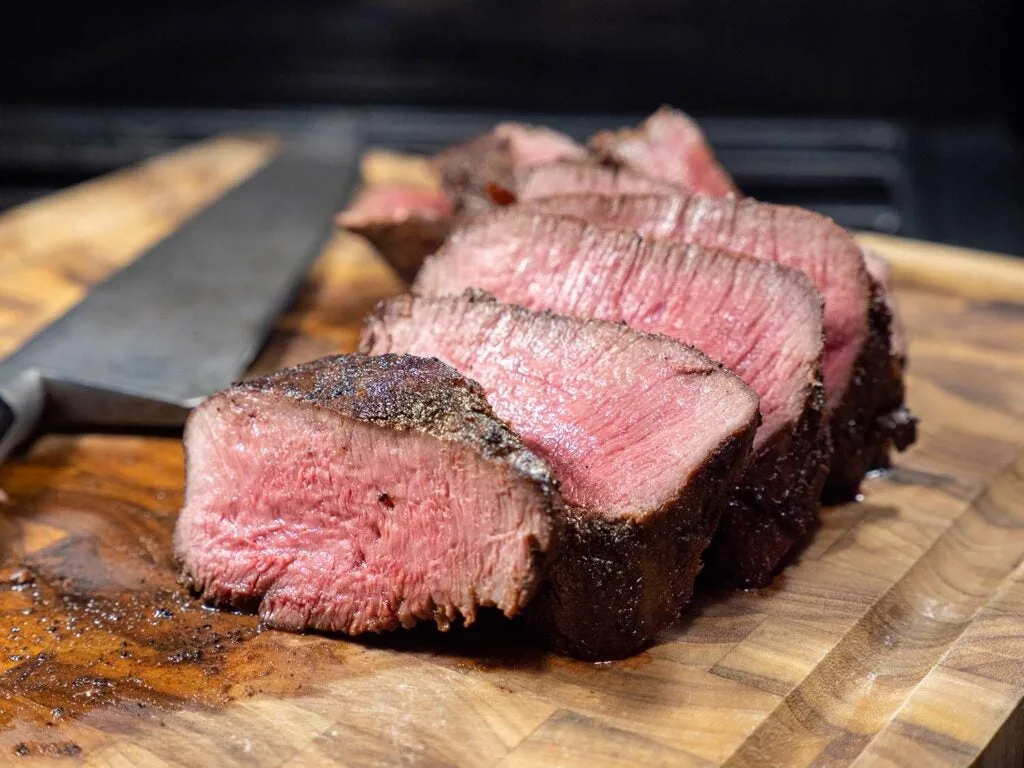
Always slice meat against the grain. (Photo: Cosmo Genova)
7) Add Sauces and Other Flavors to Your Venison Backstrap Recipes
When cooking a venison backstrap recipe, I like to use earthy herbs and spices like juniper, rosemary, cumin, cinnamon, clove, and nutmeg. Rich flavors like coffee, brown sugar, smoked paprika, etc., also work well. I usually pair backstrap with some sort of natural sweetness from berries or other fruits like apples, pears, or dried cherries. I also tend to incorporate a fat component to a lean venison dish, whether that’s in the form of oil, butter, bacon grease, or otherwise, and I like to use acids like citrus, whole grain mustard, or apple cider vinegar for a little bite to cut through the fat and richness. Pairing backstrap with condiments like chimichurri, or incorporating a vinaigrette into your dish, works perfectly for this reason.
Whatever you’re cooking, the fundamental rule is to seek balance. You want crunchy and soft textures, sweet and savory flavors, etc., and they should all flow and complement each other, but also contrast without clashing. I like to spread these flavors between the different aspects of a dish so each bite is slightly different and interesting. As cliche as this phrase has become, every meal should revolve around salt, fat, acid, and heat.
In general, you can treat a backstrap a lot like you would other lean proteins such as pork loin or filet mignon in terms of the flavors you would pair it with.
